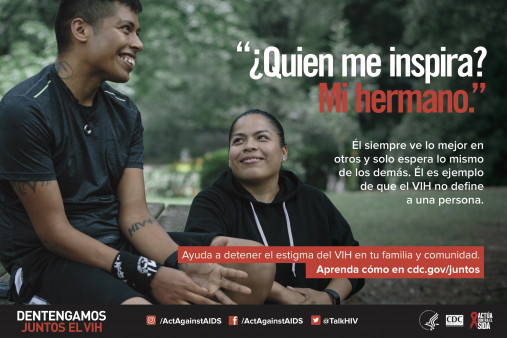In early June, the Centers for Disease Control and Prevention (CDC) relaunched its “Let’s Stop HIV Together” campaign, which aims to reduce HIV-related stigma and raise HIV awareness. Now, the CDC has released the next phase of campaign materials, which include a Spanish-language version of the campaign.
“It was important for CDC to update ‘Let’s Stop HIV Together’ with refreshed materials to support the latest trends online and on social media,” Eugene McCray, MD, director of CDC’s Division of HIV/AIDS Prevention, told POZ in an email. “It was also an opportunity to reinforce CDC’s commitment to addressing HIV-related stigma, redefine the call to action and expand the racial and ethnic diversity featured in the campaign.”
First launched in 2012, “Let’s Stop HIV Together” is part of the CDC’s and the White House’s Act Up Against AIDS (AAA) initiative, a five-year, $45 million national communication effort aimed at raising HIV awareness among all Americans and reducing the risk of infection among the hardest-hit populations.
AAA currently includes eight active campaigns targeting the general population and health care providers. “Each campaign covers basic HIV prevention awareness and risk reduction and also educates health care providers about their role in HIV prevention,” explained McCray.
Among the campaigns for the general public are “Doing It,” a national HIV testing and prevention campaign designed to motivate all adults to get tested for HIV and know their status, and “Start Talking. Stop HIV,” a campaign seeking to reduce HIV infections among men who have sex with men.
There’s also “HIV Treatment Works,” which encourages those living with HIV to get connected to care, stay in care and live well. Campaigns for providers include “Transforming Health,” “Prevention IS Care,” “One Test. Two Lives” and “HIV Screening. Standard Care.”
“To maximize the reach of Act Against AIDS, the CDC works closely with public health partners, media and other supporters that distribute campaign messages and materials, broadcast public service announcements and donate advertising space,” McCray wrote in his email.
The first phase of the updated campaign included posters, web banners, a stigma fact sheet and a language guide. Videos featuring people living with HIV and palm cards available for viewing and download have now been added to the mix of resources.
In addition, the Spanish-language version of the campaign, “Detengamos Juntos el VIH,” is now live.
“Research shows it is important for messages to reach people where they are—and the people we want to reach are in many different types of places,” explained McCray. “That’s why ‘Let’s Stop HIV Together’ provides a variety of materials that can reach people through a number of ways, both online and offline.”
He continued, “They offer visuals that represent people with HIV—as well as their loved ones—to show the powerful role that support plays in overcoming stigma and achieving better health outcomes.”
The CDC encourages folks to initiate conversations about HIV by creating their own social media posts and using the hashtags #StopHIVStigma or #StopHIVTogether. Individuals can also share, retweet and repost posts from Act Against AIDS’s social media channels.
“Reducing HIV stigma is central to our mission to promote health and prevent HIV transmission,” McCray concluded. “The CDC will continue to update ‘Let’s Stop HIV Together’ to keep people engaged in HIV prevention and to stay current with science and technology.”
To read POZ’s earlier coverage of “Let’s Stop HIV Together,” click here.

CDC

CDC







Comments
Comments